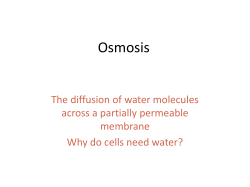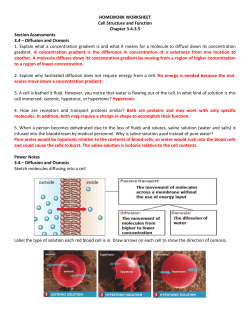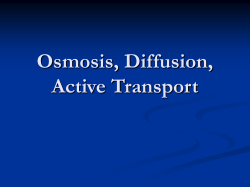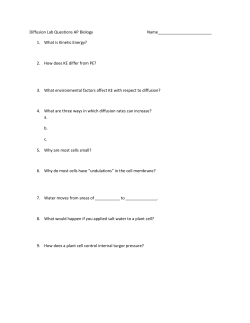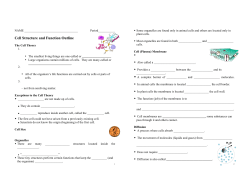
Cell Membrane Transport
Biology Day 8 Diffusion and Osmosis Pg. 275 278 There are two major categories of cell transport: a. Passive transport requires no energy input b. Active transport requires some energy input Passive Transport: diffusion, osmosis, facilitated diffusion o Movement of particles is due to differences between the cell and the fluids surrounding the cell. o Substances move according to their concentration gradient o Substances must be soluble in lipids to pass thorough the phospholipid bi layer Concentration Gradients: a. Define Concentration Gradient: The difference within a given area between the highest and lowest concentration of a given substance. . 1 Diffusion: pg. 275 276 a. Define Diffusion. The natural movement of particles from an area of high concentration to an area of low concentration. b. What must exist in order for diffusion, and all passive transport, to occur? A concentration gradient. c. Where does the energy for movement of particle come from? From the energy that particles always have. d. Does diffusion occur faster in gases or solids? Why? Occurs faster in gases because gas particles have more energy and larger spaces between the particles. e. What are 2 things that can influence the rate of diffusion? Amount of energy (add or take away) and the concentration gradient. http://www.biosci.ohiou.edu/introbioslab/Bios170/diffusion/Diffusion.html http://highered.mcgrawhill.com/sites/0072495855/student_view0/chapter2/animation__how_diffusion_works.html Facilitated Diffusion: (pg. 278) a. Define Facilitated Diffusion: Diffusion of a molecule across a membrane through binding to carrier proteins. Passive transport Does not require energy. b. Channel Proteins creates pores in the membrane that allow only molecules of a certain size to pass through by diffusion. c. Carrier Proteins attach to larger molecules, change shape, and physically move them across the cell membrane. http://highered.mcgrawhill.com/sites/0072495855/student_view0/chapter2/animation__how_facilitated_diffusion_works.html 2 Osmosis: (pg. 277 278) a. Define Osmosis: The diffusion of water across the cell membrane. Another type of passive transport b. A cell always tries to maintain a balance (equilibrium) with its surroundings. c. Osmosis occurs when there is a concentration gradient of molecules that cannot move across the cell membrane. As a result, water moves across to dilute the concentration of the molecules d. Water will move from an area of high concentration to an area of low concentration until there is an equal amount of water molecules on both sides of the membrane. e. Osmosis of water in/out of a cell in unfavorable environmental conditions may kill it. http://highered.mcgrawhill.com/sites/0072495855/student_view0/chapter2/animation__how_osmosis_works.html A Cell Can be Exposed to Three Different Environments: (pg. 278) For each of the following, define the term, determine if water moves in or out of the cell placed in the environment, and draw a diagram of a cell placed in the environment with arrows showing water movement. a. Hypertonic Environment: A solution that has a higher concentration of solutes than a cell. Water will leave a cell placed in this environment. b. Hypotonic Environment: A solution that has a lower concentration of solutes than the cell. Water will enter the cell placed in this solution. c. Isotonic Environment: A solution that has the same concentration of solutes as a cell. Water will not enter or leave a cell placed in this solution. http://www.tvdsb.on.ca/westmin/science/sbi3a1/cells/osmosis.htm http://www.youtube.com/watch?v=IRQLRO3dIp8&safety_mode=true&persist_safety_mode=1 . Turgor Pressure pressure exerted against a cell wall the by the water that has entered the cell through osmosis 3 Active Transport: (pg. 278 271) a. Define Active transport. The movement of particles against the concentration gradient. b. What are two things that are required for active transport? This requires carrier proteins and an input of energy. c. What is the name of the energy source that is needed for active transport and where is it produced? Called ATP (adenosine triphosphate) and is made in the mitochondria. http://bcs.whfreeman.com/thelifewire/content/chp05/0502002.html Two Other Types of Active Transport that don’t use Carrier Proteins: (pg. 281) Endocytosis: a. Define Endocytosis: Uptake of particles by formation of a vesicle from the cell membrane b. When is the process of Endocytosis used by a cell? When particles are too large to move across the cell membrane Exocytosis: a. Define Exocytosis: Release of molecules that fuse with the cell membrane to export the molecules from the cell. b. When is process of Exocytosis used? When molecules are too large to move across the cell membrane http://highered.mheducation.com/olcweb/cgi/pluginpop.cgi?it=swf::535::535::/ sites/dl/free/0072437316/120068/bio02.swf::Endocytosis+and+Exocytosis 4
© Copyright 2025

